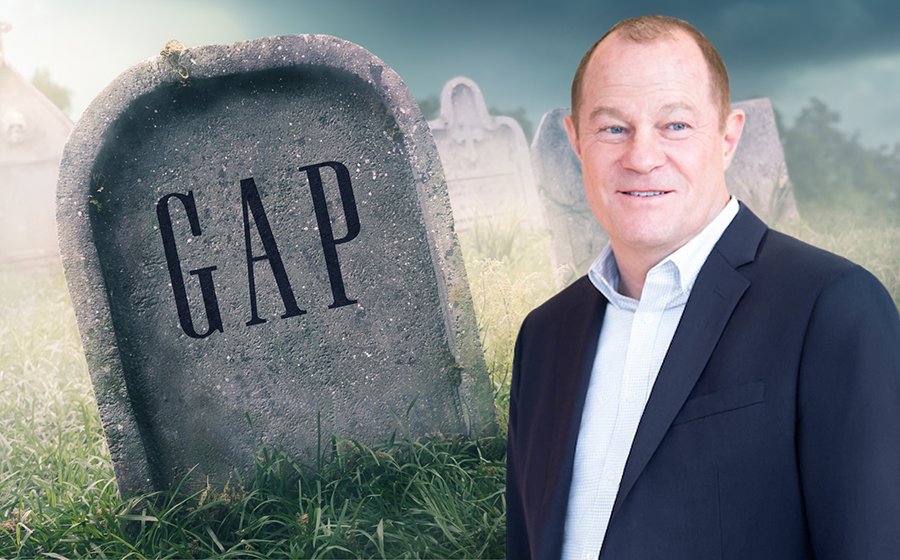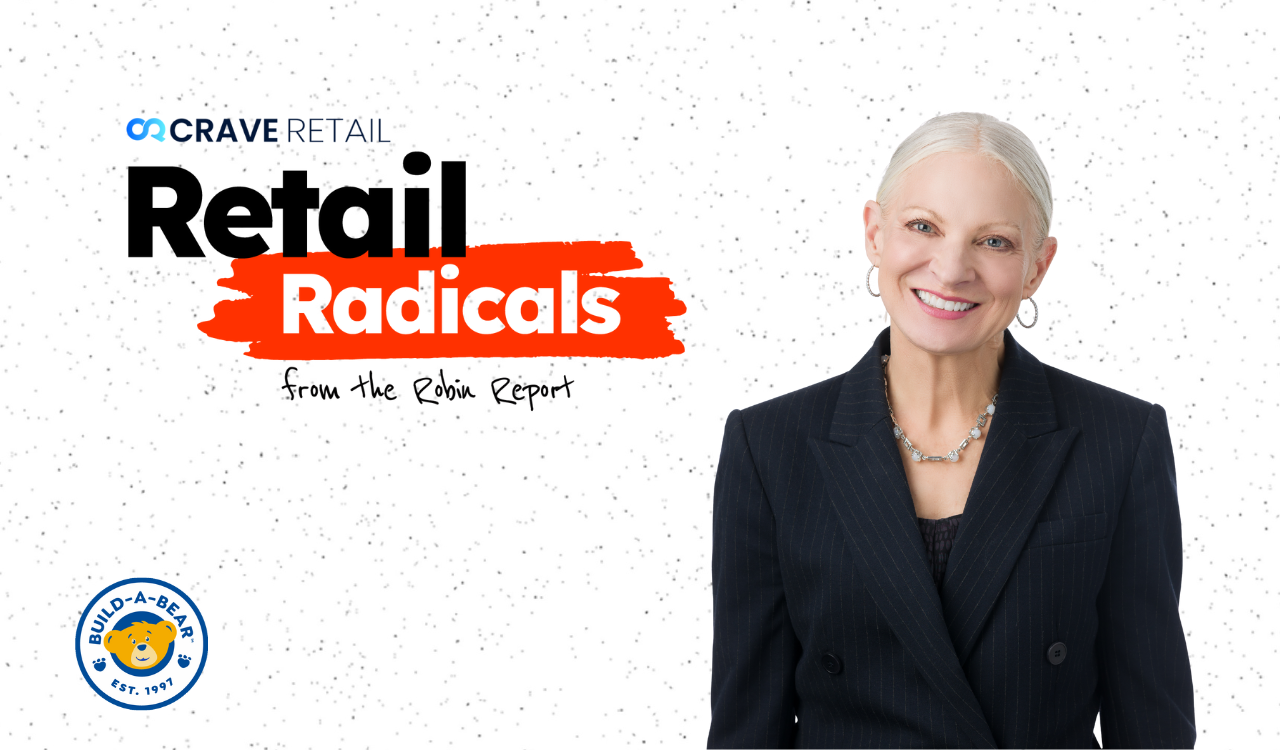Paul Pressler (CEO, Gap — 2002-2007), passed his failing patient (Gap), over to CEO Glenn Murphy who was the unsuccessful surgeon who operated on Gap while it was on life support, between 2007 and 2015. Murphy was unable to bring the patient into recovery mode. So, in 2015 he passed it along to its current CEO and undertaker, Art Peck, who seems to be putting the final nail in Gap\’s coffin as he presides over its impending death. Ever since Murphy passed the dying body over to Peck, it has continued to flatline with actual sales declines in both the Gap brand and Banana Republic. The only hint of a heartbeat has been Old Navy.
Not surprisingly, the most recent quarterly results continued the decline. Same-store sales were down 10 percent for the Gap brand, 3 percent for Banana Republic, and even down 1 percent for the only \”breathing\” brand, Old Navy. Peck warned of an \”extremely challenging\” period for Gap and indicated weaker sales and profits for the year. Accordingly, Gap\’s share value fell 10 percent following the announcement, which is a continuation of the 56 percent decline in value since 2014. And During Peck\’s tenure, Gap\’s share value has consistently been lower than the S&P and Dow averages.
Peck\’s Legacy
Peck has led this oncoming disaster without an apparent clue about how to turn it around. We have repeatedly heard his \”Wall Street-correct\” voice quarter in and quarter out. He mouths the usual bromides of cost-cutting, closing underperforming stores, eliminating jobs, hiring more capable merchants/designers, repositioning the brand and developing a fast-fashion process, blah, blah, blah … and ho-hum. Such rhetoric might kick the can down the road and buy a few more quarters of slogging but bringing the brand back to high cool-factor, it will not.
And finally, he apparently realizes the same old bromides won\’t soothe Wall Street or his shareholders. So, he has dug deeply into options looking for a \”Hail Mary\” solution. And he finds one. Gap Inc. is planning to separate the company into two independent publicly-traded companies: Old Navy and NewCo, which will consist of Gap, Athleta, Banana Republic, Intermix and Hill City. The transaction is targeted to be completed in 2020, if certain conditions are met.
In my opinion, this will make no difference for the Gap brand. It was dying when Mickey Drexler left it in 2002. His next three successors failed to resuscitate it. So, in my opinion, it is not a question of \”if.\” It is only a question of when the coffin will be lowered.
Drexler\’s Legacy
The first blow to the brand\’s life (that alone would kill it over time) ironically came from the good news of meteoric growth under Drexler\’s brilliance. That good news suddenly turned into the bad news after he scaled the business and it became ubiquitous (a Gap on every corner). And ubiquitous fashion is not only an oxymoron, it turns \”cool\” into \”uncool\” very quickly, especially among emerging NextGeners who are tenaciously creating their own more personalized and customized new world, including brands.
But let\’s say I\’m wrong and it\’s actually possible to reposition a once-cool and now-dying brand and bring it back to life. Well in my opinion, the crowning blow to the brand and assuring its demise, were the three CEOs over the 16 years that followed Drexler\’s departure.
Drexler left the helm of the brand that he guided through two decades of meteoric growth from $480 million in revenues upon his arrival in 1983 as president to almost $14 billion in 2000 — an amazing 2,400 percent increase. Indeed, his success earned him the moniker of the \”prince of all merchant princes.\” Unable to right the ship when it started to sink, Drexler retired in 2002. Comp-store sales dropped 5 percent in 2000, their first decline since 1989, and then a whopping 13 percent in 2001, with the overall Gap brand down 12 percent.
The point I want to make crystal clear is that once a hot brand turns cold and boring in a world of excessive overabundance of equally compelling brands, it\’s finished.
Over the last 16 years since Drexler\’s departure and the Gap\’s sustained collapse, it has been the occasional slogging along as a best-case scenario, shared equally among the three successive CEOs: Pressler, the first unsuccessful surgeon; Murphy, the second MASH unit surgeon, and Peck, the undertaker.
What went wrong?
Competition, Ubiquity, Momentum Complexity and the Consumer
Like silent Pac-Men, competition grew up all around the Gap and began to chomp away at all three of its brands during the 1990s. Gap Inc. and the entire apparel specialty retail sector realized explosive growth during that period, primarily taking huge chunks of market share from department stores and the specialty brands that were also competing fiercely among themselves. In fact, the rate of growth for dollars spent on teen apparel grew at an incredible 14 percent per year from the late 1990s through to the Great Recession. And many of them, like A&F, American Eagle Outfitters, Aeropostale, and Zumiez were hitting their stride right in Gap\’s sweet spot.
Even so, following Old Navy\’s repositioning in 1994, the Gap troika of brands was leading the specialty store pack through the latter half of the 1990s. In 1997, Old Navy hit a billion dollars in sales and Gap Inc. grew from $6.5 billion up to $9 billion in 1998. Plus, they were opening stores at the rate of one per day. The Gap had become the cool brand of all brands for consumers of all ages.
And suddenly, it wasn\’t.
Somewhere in the blur of skyrocketing growth, opening 731 new stores and hitting sales of $13.6 billion in 2000, Mickey Drexler and his Gap brands lost their cool. The rapid growth and store openings made the brand ubiquitous, and, as I mentioned, ubiquity is antiquity. As a result, Gap began to lose their customers in droves.
While Drexler was caught in the Gap\’s growth maelstrom, he was helpless to prevent the simultaneous declines of Banana Republic and Old Navy. Old Navy lost its consumer connection as cheap chic, and Banana Republic went from work attire to expensive dressy, the wrong positioning for the brand.
It all started to fall apart at the dawning of the new Millennium. The Gap experienced its first two years of declining sales and Drexler began to close stores and cut costs as he struggled to right the brand and reconnect with consumers. He departed in 2002 as the brands and the business began their steep descent.
Enter Paul Pressler from the \”Magic Kingdom\”
Paul Pressler came in as the new turnaround CEO in the fall of 2002. An alumni of the Disney store chain, his strengths were supposedly in the areas of operations and supply chain. Pressler was essentially a numbers guy who knew little of the nuances of fashion. Were his operational skills what Gap needed? It took Gap\’s board and owners five long years to answer that question, precious years that could have been used working towards a turnaround.
Pressler\’s \”left brain\” focus would prove that all of the strategizing, researching, operational improvements and cost-cutting in the world would not create a stylish collection or an emotionally compelling brand. Just as Mickey Drexler\’s \”right brain\” focus might have benefitted from a strong business and operational partner, Pressler\’s left-brain orientation definitely needed a strong merchant. It never happened.
So, by 2005, the brand was led into its descent by inexperience at best, and what would turn out to be a total lack of merchandising skills at worst. As Gap\’s business fell into a more accelerated decline, and the brand\’s relevance, positioning, image, consumer base and business continued to unravel, Wall Street bestowed Pressler the nickname of \”dead man walking.\”
Between June 2004 and December 2006 (eight months before Pressler would be replaced), comp-store sales declined in every month but three. Pressler stepped down in 2007. Does it surprise anyone that Gap\’s publicly stated qualifications for its next CEO at the time read: \”…with deep retailing and merchandising experience, ideally in apparel, and who understands the creative process\”?
Wow! Pressler had none of those skills. Someone finally woke up to Gap\’s real problem. But even more astounding, the search firm that served up the next CEO apparently did not read those qualifications — or Gap\’s board and owners decided to override them with their own qualifications.
From the Magic Kingdom to Canadian Drug Stores
In July 2007, Gap announced that Glenn Murphy, previously CEO of Shoppers Drug Mart in Canada, was to be the new CEO of Gap Inc. Hello? Am I missing something? Did the search firm not read \”…with deep retailing and merchandising experience, ideally in apparel, and who understands the creative process?\”
Yes, drug stores are retailers — and yes, they do carry merchandise, although not trendy apparel. And I\’m not convinced of what type of creative process thinking there is in drug stores – maybe the signage or advertising? Furthermore, there is no industry that even comes close to being as intensely competitive, fast moving and deathly cyclical as apparel retailing in the United States. To say nothing of my favorite mantra – \”share wars\” in an over-stored world.
I scratched my head then. And of course, 11 years hence, the Gap brand still does not have a compass. But the head scratching really started even before the Murphy appointment. The Gap announced in May 2007 that big name designer Patrick Robinson would become head designer for the Gap brand.
Since Murphy inherited that decision upon his arrival two months later, and because he was entering a different retail industry and a fashion and apparel sector he had virtually no experience in, and because he probably had little understanding of what a designer does or even who Patrick Robinson was in the first place, Murphy had to assume Bob Fisher (majority owner and interim CEO between Pressler and Murphy) and Marka Hanson, President of the Gap brand, had good strategic reasoning for hiring Robinson. So, he accepted the move and focused on what he understood best: operations, supply chain, cost efficiencies and productivity.
After all, why should Murphy not assume that the organizational changes made prior to his arrival – essentially replacing the key staffers of Paul Pressler – would be to place high-quality management in those areas of the business where he had less experience?
If that was, in fact, his assumption; it\’s too bad it took him four years to learn otherwise. Murphy fired Marka Hanson who was responsible for hiring Robinson in 2011 and inserted Art Peck, as her replacement. Peck had been president of Gap\’s outlet Stores, and before that, spent 20 years at the Boston Consulting Group. OMG, BCG — a big-time consultancy. Maybe they were already lining Peck up to be the next CEO? More on this later.
As an aside, but a really, really big one, Art Peck wrote a blog as Gap\’s new president saying that if anyone Googled him, \”…you won\’t find much.\” Among other things, he also said, \”That\’s right. I\’m not a merchant.\” Okay, so now we have a self-effacing CEO with drug store experience and a president of the Gap brand with consulting experience.
Again, am I missing something? The new president of the Gap is not a merchant? Again, go figure.
Art Peck Inherits the Patient on Life Support
Gap Inc. went on to gain some minimal growth from $14.5 billion in 2011 to $15.6 in 2012. But it was largely driven by Old Navy, as was the meager growth in 2013, (roughly 3 percent to about $16.1 billion). In 2014, Gap Global had minus-5 percent comp store sales; Old Navy Global had a 5 percent increase, while Banana Republic\’s Global same store sales were flat. And in the first quarter of 2015, same-store sales crashed by 10 percent, compared to a 5 percent drop in the same quarter from the preceding year.
All of this now leads to another déjà vu crisis moment. CEO Art Peck\’s bromides about cost-cutting, closing stores and the fact that his team is all over the issues and challenges, and now with a \”spin-off\” strategy, are supposed to indicate yet, once again, that there is hope for a turnaround.
Hope and reality sometimes serendipitously merge. But they have not, and in my opinion, they will not for The Gap. Upon, Mr. Peck\’s arrival he needed to address a laundry list of realities which he did not do, and I believe it\’s now too late.
The brand is cold and descending, particularly among millennials who are now the primary consumer segment for apparel. Everything the brand used to stand for among America\’s youth has been co-opted by fast fashion brands like H&M, Forever 21, Zara, Uniqlo and others, many of them tech-driven startups. These young consumers want more new, more often, whenever they want it. Fast fashion compels greater visitation rates due to more frequent and faster new line cycles, and most importantly, these brands also offer greater value.
Today, consumers have instantaneous and unlimited access to whatever their hearts desire, a key tap away or in a store across the street, thus upping the ante for even strong brands in a fierce over-stored market. Turnaround brands like the Gap face almost impossible odds.
Millennials can scan through more stores and brands in 10 minutes than spending a whole day shopping and forget about hanging out all day in the malls. The mall sits comfortably in their pockets wherever they are.
Millennials are less interested in buying brand identities than in creating their own unique style. They\’re into exclusivity and individual expression. Cool is most often something nobody else has (again, ubiquity is the anti-cool).
Physical retail estate is shrinking for both stores and malls as e-commerce accelerates, challenging Gap\’s mall locations. Physical stores must create great experiences to compel young consumers to take the time to come to and shop through the stores; the Gap in-store experience is lackluster at best.
Smartphones are providing a wide range of more entertaining and enjoyable experiences for millennials to spend time and dollars on than shopping for apparel.
Is it too late for Mr. Peck and his team to address these realities in ways to successfully merge his hope with these real-world issues? Can they bring the Gap brand back to a level cool enough to be embedded into the zeitgeist of today\’s youth? Or are we looking at another iconic brand in its death throes? Spoiler alert: that\’s the opinion I opened this article with.
Peck\’s Undertaking
Is the Old Navy and New Co. separation a \”Hail Mary\” strategy to give Old Navy an un- anchored, independent growth runway, while Peck and his teams focus on the other brands, primarily to revive The Gap brand?
In my opinion, Mr. Peck and team will slog through this third Gap descending period, having accomplished nothing more than his predecessors, by just keeping the brand alive. The question then would be: Will The Gap Inc. board, its owners and Wall Street allow yet a fourth attempt at a turnaround?
As I close on that question, I need to repeat Gap Inc.\’s publicly stated qualifications for its next CEO, following the departure of Paul Pressler in 2007. At the time it read: \”…with deep retailing and merchandising experience, ideally in apparel, and who understands the creative process.\”
I also need to repeat that line from Art Peck\’s blog, which he wrote as Gap\’s new president. He said of himself that if one Googled him, \”…you won\’t find much.\” And, among other things, said, \”That\’s right. I\’m not a merchant.\”
To summarize, the brand collapsed and lost its cool in the early 2000s. Over the course of the next 15 years, it was steered under the leadership of two CEOs, neither of whom fit the publicly stated qualifications required by Gap Inc. in 2007. And now the brand has as its CEO, Art Peck, a consultant for most of his career who publicly admitted to not being a merchant.
I rest my case. Gap will continue its descent with a whimper and likely a long and painful death. The only question is: will Art Peck be around as the acting undertaker?




